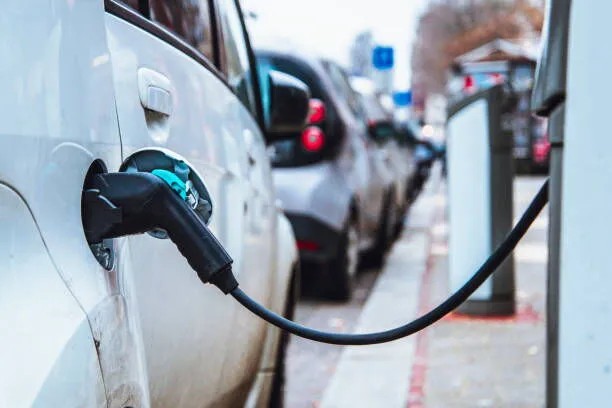110V vs. 220V EV Charging: What You Need to Know

Strong 8k brings an ultra-HD IPTV experience to your living room and your pocket.
110V vs. 220V Charging: What EV Owners Need to Know
Powering the Future of Mobility
As a professional EV charger manufacturer in China, Topper Company delivers dependable electric vehicle charging station equipment and comprehensive charging solutions.
As electric vehicles (EVs) become a bigger part of our daily lives, one question stands out: how should you charge them? Whether you’re a new EV owner or simply curious about making the switch, understanding your home charging options is essential to getting the most out of your vehicle.
While EVs boast lower running costs, zero tailpipe emissions, and cutting-edge technology, charging speed can often be a pain point—especially if you don’t have the right setup at home. The most common residential charging options in North America use either 110V or 220V outlets, and the difference between them is massive.
In this guide, we’ll explore the key differences between 110V (Level 1) and 220V (Level 2) charging, highlight their pros and cons, and help you decide which is the better fit for your lifestyle.
What is a 110V Charger? (Level 1 Charging)
A 110V charger—also known as a Level 1 charger—is the most basic and widely available way to charge an EV. It plugs into a standard household outlet, just like your phone or coffee maker, and typically comes with the vehicle.
How It Works
Voltage: 110–120V
Current: ~12 amps
Power: ~1.2 kW
Charging Speed: ~3 to 5 miles of range per hour
Pros of Level 1 Charging
No installation required: Just plug in and charge.
Low cost: Uses your existing outlet—no upgrades needed.
Safe and simple: Designed for everyday home use.
Cons
Very slow: Charging a long-range EV can take 2–3 days.
Not ideal for frequent driving: If your daily commute exceeds 30–40 miles, Level 1 likely won’t keep up.
Inefficient over time: Prolonged charging can lead to greater energy loss through heat.
What is a 220V Charger? (Level 2 Charging)
A 220V charger—or Level 2 charger—offers faster charging by tapping into the same voltage used by large appliances like dryers or ovens. This setup typically requires a dedicated outlet or hardwired wall unit and professional installation.
How It Works
Voltage: 220–240V
Current: 16–40 amps or more
Power: 3.3–19.2 kW
Charging Speed: ~25 to 35 miles of range per hour
Pros of Level 2 Charging
Fast and efficient: Recharge your EV overnight in 4–10 hours.
Convenient for daily use: Handles regular commutes with ease.
Future-proof: Ideal for long-range EVs or two-EV households.
Cons
Upfront cost: Equipment and installation can cost $500–$2,000.
Professional setup required: Most homes need a licensed electrician.
Not always plug-and-play: Older homes may need electrical panel upgrades.
110V vs. 220V Charging: Quick Comparison
Feature 110V (Level 1) 220V (Level 2)
Voltage 110–120V 220–240V
Power Output ~1.2 kW 3.3–19.2 kW
Range Added/Hour 3–5 miles 25–35 miles
Full Charge Time 24–72 hours 4–10 hours
Installation Not required Required
Best For Light/occasional use Daily drivers
Upfront Cost Minimal Moderate to high
Can You Use an Adapter to Convert 110V to 220V?
In short—no, and it’s dangerous to try. Adapters don't convert voltage or increase power capacity. Level 2 charging requires a true 220V circuit with the right amperage and safety features. Using a standard adapter can lead to fire hazards or damage your EV’s charging system.
If you already have a 220V outlet—for instance, in your garage or laundry room—you might be able to use it for Level 2 charging with a portable EVSE (Electric Vehicle Supply Equipment). Just make sure to:
Confirm the outlet’s amperage matches your charger.
Use UL-listed or certified adapters.
Follow all local electrical codes—and consult an electrician.
Smart Features of Modern EV Chargers
Today’s Level 2 chargers do more than deliver power. Many offer smart features, including:
Wi-Fi or Bluetooth connectivity
Scheduled charging to save on electricity during off-peak hours
Mobile app controls for remote monitoring
Energy tracking and efficiency insights
These extras make charging more cost-effective, convenient, and sustainable.
What Does It Cost to Charge at Home?
Here’s what you can expect when it comes to cost:
Level 1 Charging
Charger cost: Included with the EV
Installation cost: $0
Electricity cost/month: ~$20–$50
Level 2 Charging
Charger cost: $300–$700
Installation cost: $500–$1,500
Electricity cost/month: Similar to Level 1 but more efficient
While Level 2 charging has a higher upfront cost, the time savings and convenience usually make it worthwhile for most EV owners.
Which Option is Right for You?
Ask yourself:
How far do I drive each day?
Under 30 miles? Level 1 might be fine.
Longer commutes? Level 2 is highly recommended.
Can I charge overnight?
Level 1 is only practical if you can plug in for 12+ hours.
Level 2 allows flexible top-ups any time.
Is my home ready?
Older homes may need an upgrade for Level 2.
Newer homes often have accessible 220V outlets.
Will I own an EV long-term?
A permanent Level 2 setup is a smart investment.
Am I eligible for rebates?
Many states and utilities offer incentives for EV charger installation.
Final Thoughts: Smarter Charging for a Greener Drive
Charging is a critical part of the EV ownership experience. While 110V (Level 1) charging is great for beginners or those with short daily drives, it’s not a long-term solution for most drivers.
Upgrading to 220V (Level 2) charging opens the door to faster, smarter, and more reliable charging—making your EV truly practical for everyday use. With the right setup, you’ll not only save time but also get the most out of your vehicle and investment.
The future of driving is electric. Make sure your home charging setup is ready to power it.Gotta know about Google SEO.
Note: IndiBlogHub features both user-submitted and editorial content. We do not verify third-party contributions. Read our Disclaimer and Privacy Policyfor details.


